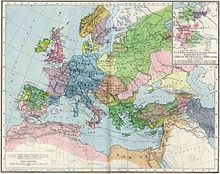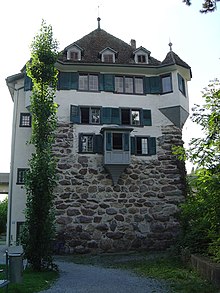High Middle Ages
As the High Middle Ages or high Middle Ages in which it is medieval studies which until the mid-13th century, lasting from the mid-11th century era in the Middle Ages called (about 1050-1250). In a scientific sense, the term is primarily related to Christian-Latin Europe (especially Western and Central Europe). The term does not apply to the neighboring Byzantine or Islamic area and non-European history, or only to a very limited extent, even though Byzantium and the Islamic cultural area are also considered in historical research.
The early Middle Ages preceded the High Middle Ages . The epoch following the High Middle Ages is known as the late Middle Ages .
Characteristics
The distinction between the High Middle Ages and the Early Middle Ages is made differently. The middle of the 11th century is common as the beginning period in research, because from this time a comprehensive change took place in Latin Europe. Economically and culturally there was a new development. This change was triggered by population growth that continued into the 14th century . New areas had to be opened up and production methods improved to increase yields. This promoted craft and trade (including new trade routes) and thus in turn the money economy. A banking system developed, especially in northern Italy. New markets emerged, which in turn filled the cities' coffers . A social mobility unknown since ancient times developed, both geographically and in terms of social class. Technical advances came along with the economic boom.
Christianization was largely complete in Northern Europe and large parts of Eastern Europe. The church with the well-established papacy developed a clear hierarchy internally; externally, it fought with the secular rulers for supremacy. These power struggles were criticized by many contemporaries. This is how church reform movements arose in Germany . During this time, however, there was also an investiture dispute and, in the period that followed, repeated conflicts between the Roman-German emperors and the papacy. The popes certainly strived for control of secular rule, but this was not without contradiction ( two swords theory ). The high Middle Ages were also the heyday of religious orders such as the Cistercians and Premonstratensians .
New cathedral and monastery schools emerged, and above all the first universities were founded. There theology , medicine (especially in France ) and law (especially in Italy and especially in Bologna ) were taught. This educational revolution was made possible by the rediscovery of ancient writings (such as that of Aristotle ) that came to Western Europe from the Arab and Byzantine regions. As a result of this process, scholasticism now determined scientific thinking.
Reading and writing were no longer just skills of the clergy , although there were some lay people who had this knowledge as early as the early Middle Ages. Some officials ( ministerials ) and aristocrats also learned it. The literature served the new readers by dealing not only with spiritual and philosophical subjects. It was no longer only written in Latin , but also in the local language. In addition to spiritual themes, nature and everyday life were also painted. The Romanesque predominated in architecture . The people who were financially able to do so were able to move relatively safely and freely within large parts of Latin Europe.
The crusades also began in the Middle East, which later also targeted Spain (against the Islamic south) and the Baltic region. The high Middle Ages were also the heyday of knighthood , which was redefined as a result of those crusades (see Order of Knights ).
A reorganization took place in the state sector. The Roman-German Empire finally lost its hegemonic position. Salian rule was shaken by the investiture controversy in the late 11th and early 12th centuries. The Hohenstaufen in the 12./13. In the 19th century it was not possible to prevent the loss of royal power in the empire, although the Italian policy also tied strong forces in imperial Italy . Meanwhile, France and England gained increasing political influence. The English house Plantagenet also had large possessions in France, which repeatedly led to fighting with the French kings, who seized their power in the 12th and 13th centuries. Consolidated in the 19th century. Byzantium lost almost all of Asia Minor to the Seljuks in the 11th century , regained parts of it in the 12th century, but has only been a regional power since the fatal 4th Crusade .
terminology
The French term Haut Moyen Âge refers to the early Middle Ages, so it begins with the migration of peoples . The German term Hochmittelalter corresponds to le Moyen Âge classique or le Moyen Âge central in French . On the other hand, the Haute Renaissance and High Renaissance denote one and the same period. Italian history usually distinguishes two phases: the Alto Medioevo (before 1000) and the Basso Medioevo (after 1000); Less common is the inclusion of a middle phase, the Pieno Medioevo ("full" Middle Ages), which corresponds to the German high Middle Ages . The three-phase model corresponds to the names Alta Edad Media , Plena Edad Media and Baja Edad Media in Spanish . The phase model widely used in English corresponds to the one commonly used in German: Early Middle Ages - High Middle Ages - Late Middle Ages .
literature
- The New Cambridge Medieval History . Volumes 4 through 5. Cambridge 1999-2004. [comprehensive manual]
- Gebhardt. Handbook of German History . Volume 4 to 6. Stuttgart 2003ff. [important manual, still to be published]
- Michael Borgolte : Europe is discovering its diversity. 1050-1250 . (Handbook of the History of Europe 3), Stuttgart 2002. [Introduction with numerous references]
- Hermann Jakobs : Church reform and the high Middle Ages 1046–1215 ( Oldenbourg floor plan of history 7). Munich 1999 (unv. ND of the 3rd edition 1994).
- Jacques Le Goff : The high Middle Ages (Fischer Weltgeschichte Bd. 11). Frankfurt / M. 1965 (numerous editions).
- Bernhard Schimmelpfennig : Kings and princes, emperors and popes in the 12th century. (Encyclopedia of German History, Volume 37). 2nd edition Munich 2010, ISBN 978-3486596786 . [Introduction with presentation of the state of research and bibliography]

